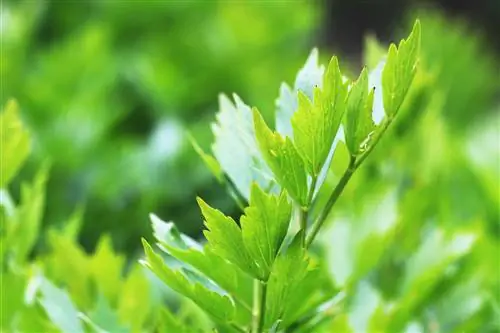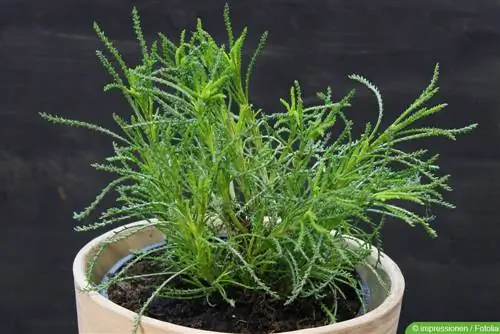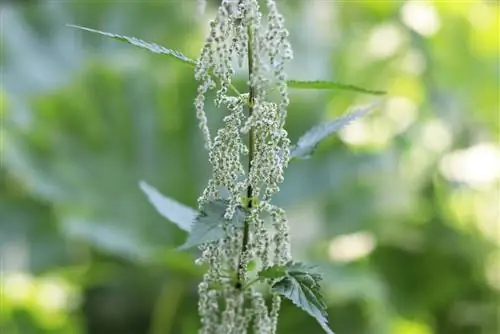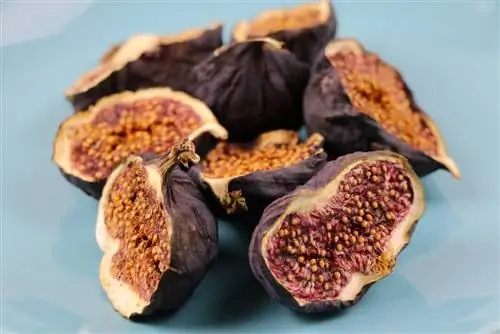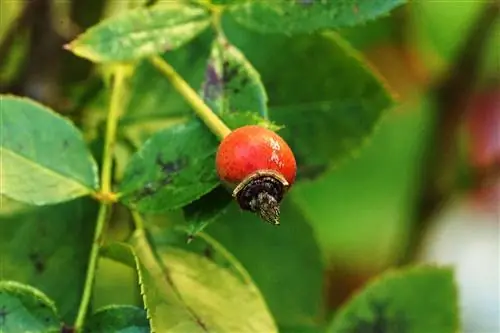- Author admin [email protected].
- Public 2023-12-17 03:39.
- Last modified 2025-01-24 12:45.
If lovage is not used fresh quickly, it wilts and loses a lot of its aroma. If you don't use it immediately in the kitchen, you can preserve it by drying and freezing.
Time to harvest
The time for harvesting is crucial because the intensity of the aroma depends on it. Lovage goes through different stages of development in which the aroma forms, reaches its peak and then levels off again. Since aroma is lost through drying and freezing, the best time to harvest is between May and June. Once the flower appears, the flavor intensity decreases due to a reduction in the essential oils in the leaves. In addition, the weather should be taken into account when harvesting because it also influences the aroma and is important for the he alth of the remaining plant. Therefore, you should choose a day that meets the following criteria:
- dry and warm
- late morning, when the sun has already warmed the ground and dew has evaporated
- no hot midday sun, as it promotes drying and loss of aroma
Tip:
If the harvest time has been missed until June and before flowering, the seeds can also be used for seasoning. They are more aromatic than leaves, can be harvested from August after flowering and can be preserved in the same way.
Harvest Frequency
If you plan to dry and/or freeze the maggi herb, you should harvest it in portions. The most extensive harvest yields can be obtained if the plants were grown in February. This extends the harvest time until flowering. When the first harvestable leaves appear in May at the latest, the following should be noted:
- early harvest promotes the formation of new shoots
- more new shoots increase harvest frequency and consequently crop yields
- only harvest if drying/freezing takes place immediately afterwards, otherwise there will be a loss of quality and taste
- Always cut off entire stems (only use sharp, disinfected cutting tools)

Cleaning lovage
Once the maggi herb has been harvested, it must be processed further immediately because it immediately loses its aroma and “stability” once it is separated from the plant supply. Brushing/cleaning is a required step in preparation for freezing and/or drying.
How to do it:
- only wash under a soft stream of water if there is a lot of dirt
- then carefully pat dry with kitchen paper
- ideally, carefully shake off dirt from harvested stems/leaves
- remove sick, wilted, nibbled or otherwise damaged leaves
- leave usable leaves on stems if necessary
Drying maggi herb
Drying the maggi herb is the most frequently used method to preserve the kitchen spice for several months. This can be done in three different ways:
Air drying:
Two methods can be selected for air drying
Hanging as a bouquet
- Bind dry herb loosely at the stem ends using standard household sewing thread to form a bouquet
- do not tie too tightly for sufficient air circulation
- Hang upside down in a suitable location
- Drying time: between seven and twelve days depending on thickness and size
- Drying process complete when leaves rustle together and stems break easily
NOTE:
Seeds, including the inflorescence and stem, are also tied together into bouquets and dried. Paper is also placed underneath so that any falling seeds can be caught.
Spreading on an air-permeable surface
The best substrate for this drying method is cotton gauze or a close-meshed grid. In the latter case, it is important to ensure that the net does not rest directly on a sealed/airtight surface. This would have a significantly negative impact on the drying process and, in the worst case, make the project unsuccessful. Therefore, the grid must, for example, be stretched on a frame at least five centimeters high or hang freely between two “brackets”. Please note:
- Lay leaves with stems individually on wire (should not overlap)
- turn carefully every two to three days
Suitable drying place
For the Levisticum officinale to dry optimally, the drying location should meet certain requirements:
- Temperature: between 20 and 30 degrees Celsius
- Darkness
- free from dust and insects/pests
- good ventilation
Tip:
In any case, avoid drying in the sun. This would greatly promote the volatilization of the essential oils, so that within a few hours you would hardly be able to taste any aroma.
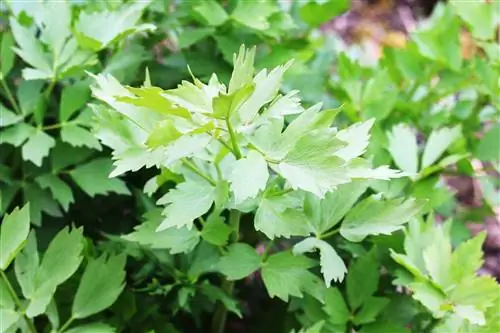
Drying in the dehydrator
The dehydrator offers an alternative to air drying the Maggi herb. It is just a different version of drying that achieves the same results, such as keeping it for months and preserving the aroma. However, the drying time is significantly shorter than with conventional air drying. Proceed as follows:
- Temperature not above 40 degrees Celsius for gentle drying to preserve aroma
- Distribute shoots evenly on drying sieve
- for devices with several sieve levels, set the rotation to accelerate drying
- Duration: one to two days
Oven drying
When drying in the oven, just like with a dehydrator, the heat generated ensures a faster drying process. Since this achieves its goal after just a few hours, oven drying is the quickest option. The details of the procedure are as follows:
- set lowest oven temperature (not above 45/50 degrees Celsius)
- Line baking tray with baking paper
- Distribute the shoots evenly on baking paper without overlapping
- Leave the oven door slightly open to allow moisture to escape (place a wooden spoon or similar heat-resistant object in between)
- fully dried when browning is visible, leaves rustle and stems break easily
Storage
The dried and completely cooled lovage is stored in a dry place without sunlight. A kitchen cupboard or windowless pantry, for example, are ideal. The culinary herb is only crushed when used. Until then, it should be stored in closed, airtight containers. These could be, for example:
- old jam or pickle jars
- Mason jars
- Plastic containers
- sealable freezer or storage bags
- vacuum sealed packaging
Freeze maggi herb
Unlike drying lovage, it can also be chopped before freezing. This makes this method the only way to preserve leftover leftovers that have already been processed for up to a year. In addition, the herb can be chopped up or stored as individual leaves in existing containers, which is usually easier than long stems. But that is up to each individual. It makes no difference to the aroma and shelf life whether the Maggi herb is frozen whole or in pieces. Only the procedure is different.
Sliced/chopped
If you want to have the Maggi herb ready to use after thawing, store it chopped up in the freezer and portion it into the desired quantities. Then it continues as follows:
- place chopped herbs in ice cube tray
- fill up with some water
- Alternative: use oil instead of water
- freeze in the freezer
- Pour ice cubes into freezer bags/containers and place back in the freezer
Leaves:
Whole leaves are usually too large to fit into the small compartments of ice cube trays. For this reason, they are usually only frozen in freezer bags or containers. Simply fill in the leaves immediately after harvesting and place them in the freezer. If you want to freeze in portions, you should follow a slightly different procedure to avoid the leaves freezing together. This makes it much easier to remove portions later.
- Line a baking tray or similar with baking paper
- Separate leaves from stems and spread evenly on baking paper without overlapping
- Pre-freeze in the freezer for a few hours
- then transfer to a suitable container and freeze
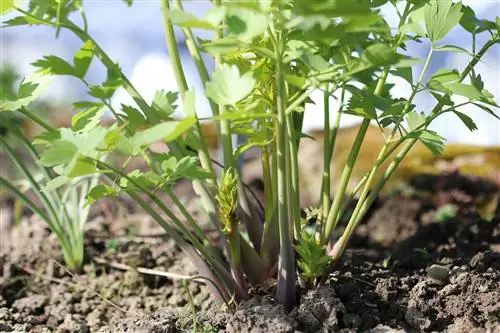
Stems:
Because the stems are usually always cut deeply during harvest, they are usually relatively long. Most of the flavor is retained when frozen if the leaves remain on the stems. However, this also requires appropriately large freezer containers. If these are not available, the stems can be divided. The fewer pieces you cut, the more aromatic the maggi herb remains after thawing.
Tip:
After thawing, lovage takes on a mushy consistency. This makes the herb difficult to cut/chop. It is therefore advisable to process it while it is frozen.
Suitable freezer containers
Cold-resistant containers and bags can be used to freeze lovage. It is important that they can be closed at least somewhat airtight, otherwise there is a risk of freezer burn and opening the freezer can have a negative effect on the herb. For a reliable shelf life of up to one year, the following are best:
- vacuum sealed freezer bags
- reusable freezer bags with zip, from which the air is squeezed out before freezing
Not suitable:
- Glass, as it quickly cracks/bursts when thawing due to temperature differences and makes herbs unusable due to broken glass
- lidless, non-lockable containers
- simple cling film, as there is no protection against freezer burn
- Paper bags or containers, as they soften due to moisture and stick to the lovage
Freeze after thawing
If lovage has not been frozen in portions and therefore needs to be defrosted for use in larger quantities, the resulting leftovers are only partially suitable for re-freezing. Unlike meat and fish, there are no he alth concerns, but due to the mushy consistency caused by thawing, the herb freezes almost completely. This is due to the increased moisture content. When it thaws again, the increased ice crystals have destroyed almost all of the cell structure, which has a particularly negative effect on the aroma. A new freeze is therefore possible, but not recommended.

